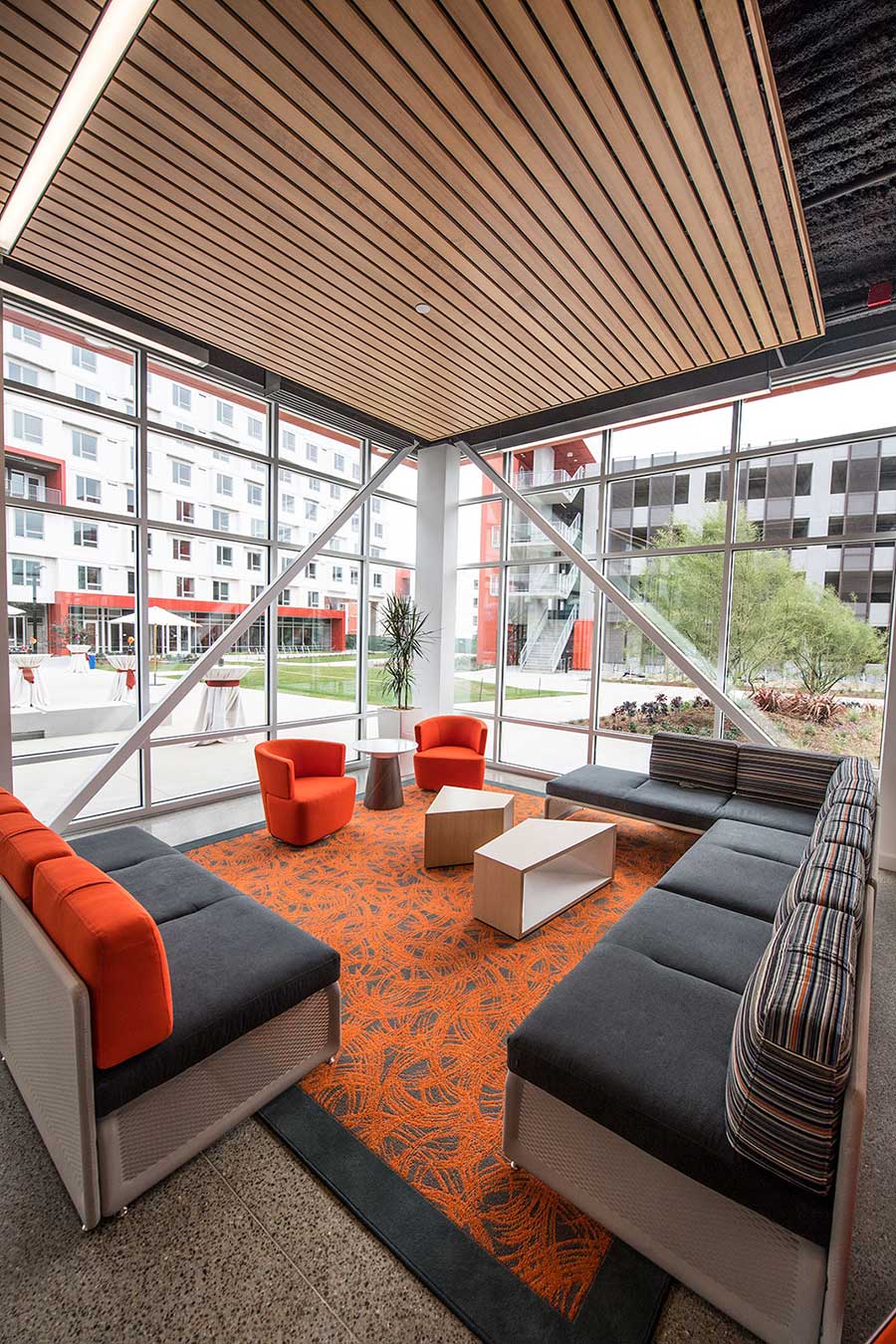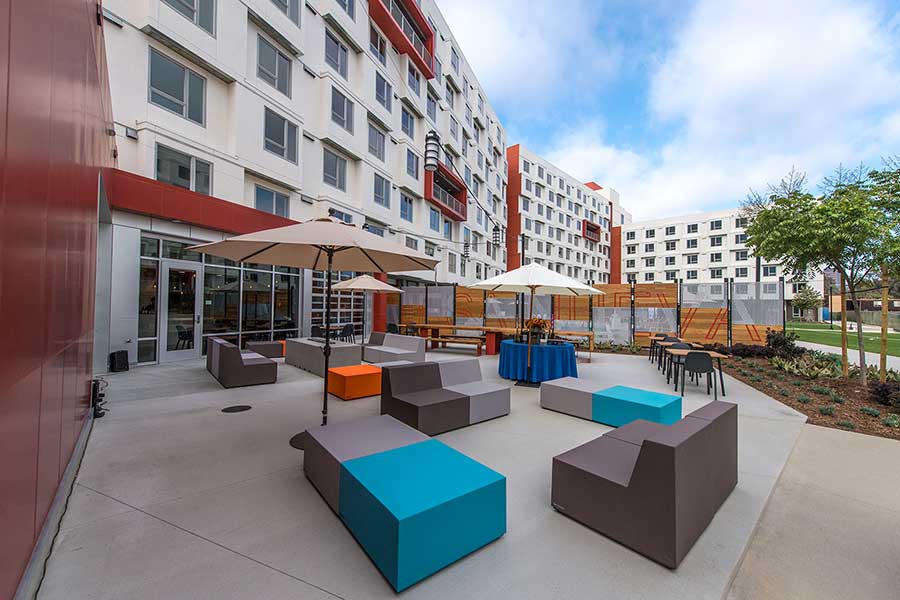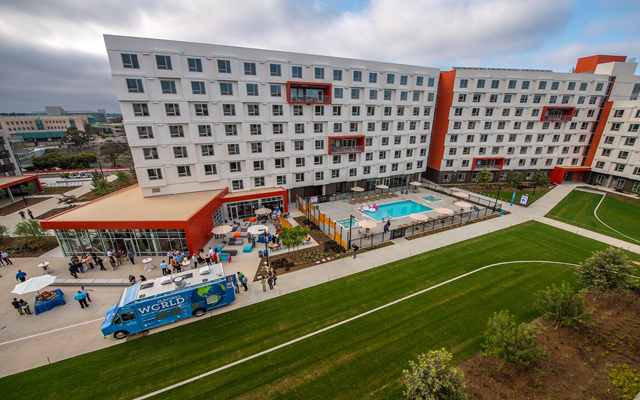
UC San Diego Unveils Mesa Nueva: One of the Nation’s Largest Graduate Housing Communities
The 1,350-bed project responds to the demand for sustainable and affordable housing on campus
Published Date
By:
- Christine Clark
Share This:
Article Content
The University of California San Diego’s newest housing project, Mesa Nueva, was recently completed and graduate and professional students have begun moving in for the start of fall quarter, Sept. 28. With the addition of 1,350 new beds, the residential community is one of the largest graduate and professional student housing programs in the University of California system and one of the biggest in the country.
In addition to being on track for LEED (Leadership in Energy and Efficient Design) Gold Certification, the new units answer a demand for both housing space and a greater sense of community for students. The new developments north of La Jolla Village Drive and west of Regents Road replaced 86 older units, built nearly 50 years ago, with new layouts and a number of new amenities, such as a small grocery store, coffee shop and other elements.
“This new housing for our graduate students is part of our overall effort to enhance the student experience at UC San Diego and advance our Strategic Plan goal of expanding our graduate student population,” said Chancellor Pradeep K. Khosla. “Our graduate students are vital to the university, as they propel our research and contribute to our innovation and success.”
The five side-by-side buildings were constructed on 10 acres that are part of UC San Diego’s existing Mesa Residential Apartments. The apartments are along Miramar Street, on a loop that connects to Regents Road. The new units surround an open space where students can gather to play volleyball, bocce ball or relax on the grass.
“Development of these student housing projects presents an opportunity for UC San Diego to meet our on-campus housing goals and address the demand from our students to live on campus,” said Mark Cunningham, assistant vice chancellor of Housing, Dining Hospitality. “With more students living on campus, this will help lessen the impact on the surrounding community with regards to issues such as housing, traffic and parking. We will continue to engage the public as we move through this process.”
Housing that creates a greater sense of connectedness
Caltrans is in the process of building a new Gilman Bridge adjacent to Mesa Nueva over Interstate 5 that links the east and west parts of the campus together via Gilman Drive and Medical Center Drive. To enhance this new east/west campus connectivity, UC San Diego will construct a pedestrian/bike bridge that will provide a direct connection for the students in the Mesa Residential Apartments neighborhood to the new bridge, which will allow them easy access to campus without needing to use a personal vehicle.

With the addition of the bridge, and the new layout of the residences, Mesa Nueva is designed to create a greater sense of community between the campus and the graduate and professional students.
The location of Mesa Nueva is south and west of the planned Light Rail Trolley stations which will serve major activity centers, such as Old Town, UC San Diego and Westfield UTC.
The construction of the eight-story buildings and surrounding area includes a 900-space parking structure.
Students in the apartments are already taking advantage of the various forms of alternative transportation accessible to the neighborhood, such as car sharing, shuttle service, walking and/or riding bikes. These options, plus the future trolley service, should lead to less impact on local streets as opposed to other typical residential projects, while also reducing the students’ dependency on personal vehicles as their primary mode of transportation.
To support this new connectivity, the campus also is providing one bike rack for every resident, as surveys revealed 73 percent of students who want to live on campus indicate that they would use a bicycle as their primary mode of transportation.
“We want to try to get people out of their apartments and use the opportunities these spaces provide to gather and engage in their community for a healthy lifestyle that also supports environmental sustainability,” Cunningham added.
Supplying affordable housing options to students
The average age of UC San Diego’s graduate students is 25, and the residents live on an average stipend of $19,000 a year and work on campus. This makes it important for them to live nearby at an affordable price. The university strives to keep rental rates at least 20 percent below the adjacent private sector market, charging on average about $750 a month per person with all costs included.

UC San Diego’s Long Range Development Plan goal is to house at least 50 percent of eligible students on campus. As of fall 2017, that number will be approximately 40 percent; with the additional housing projects underway, the campus expects to be at approximately 49 percent in fall 2020 with more anticipated student growth on the way.
Housing at UC San Diego is a campus auxiliary operation, which is completely self-funded and does not depend on federal, state, University of California or UC San Diego funding. All costs are paid for by the users – no state or local tax money is involved. Living on campus is optional for students and is not a requirement.
Sustainable building as good as gold
Mesa Nueva is on track to be LEED Gold Certified and features: Renewable energy sources, low-flow plumbing fixtures, drought tolerant/native planting, enhanced daylight harvesting for energy efficiency as well as covered bike storage and alternative transportation enhancements.
UC San Diego is committed to meeting UC system-wide goals of achieving at least LEED Silver Certification for all new buildings and LEED-CI (Commercial Interiors) Certification for all major renovations.
By achieving LEED ratings, the campus is re‐thinking how campus buildings are designed, constructed, maintained and operated with respect to six major categories: Sustainable sites, water efficiency, energy and atmosphere, materials and resources, indoor environmental quality, and innovations in design.
For more information about Mesa Nueva at UC San Diego, click here.
Share This:
You May Also Like
Stay in the Know
Keep up with all the latest from UC San Diego. Subscribe to the newsletter today.



